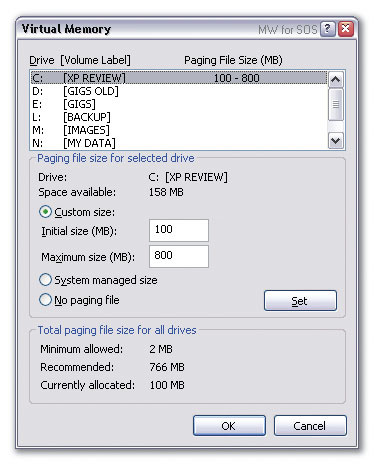Page file set to 512mb

Posted April 4, Share this post Link to post. PsychoSword 0. EddiE 0. Posted April 5, I put in an old 2gb harddrive and told Win2k to use the whole thing as swap space. Value 20gb Seagate 6gb WDCaviar 1. Ge0ph 0. Skip to main content. This browser is no longer supported. Download Microsoft Edge More info. Contents Exit focus mode. Please rate your experience Yes No. If you think the virtual memory file is too big and occupying a lot of space, follow these steps to change virtual memory size.
Virtual Memory, also known as Paging file is a system file that is mainly used to extend the system-committed memory, store infrequently accessed pages or files and even dump crash logs and other information. There is no set size for virtual memory file. Windows automatically decides the size of the paging file depending on factors like how much RAM your system has and the size of the hard drive. Again, you are confused about what the term "Virtual Memory" really is.
Windows implements a virtual memory system based on a flat linear address space that provides each process with the illusion of having its own large, private address space.
Virtual memory provides a logical view of memory that might not correspond to its physical layout. At run time, the memory manager, with assistance from hardware, translates, or maps, the virtual addresses into physical addresses, where the data is actually stored. Figure illustrates three virtually contiguous pages mapped to three discontiguous pages in physical memory.
Because most systems have much less physical memory than the total virtual memory in use by the running processes, the memory manager transfers, or pages, some of the memory contents to disk. Paging data to disk frees physical memory so that it can be used for other processes or for the operating system itself.
When a thread accesses a virtual address that has been paged to disk, the virtual memory manager loads the information back into memory from disk. The pagefile is just a portion of Virtual Memory, which is just a backing store form some data. NT requires everything in memory to have a backing store in disk so it can free up that memory if it ever needs to.
Most things can be paged back to their original respective files i. So, if you do disable the pagefile, you are not disabling paging in any way. If you were really to disable paging you would lose both per-process protected address spaces and protection of kernel mode pages from user mode access. So basically, turning off paging just can't be done.
When you do disable the pagefile, you are just forcing the system to keep all "private" virtual memory in RAM and only allowing code and mapped files to be paged. Even if the "private" stuff has not been touched for hours and will never be touched again, it will have to stay in RAM. This means that there will be more paging of code, for a given workload and RAM size. Paging can also not be correctly balanced between code, mapped files, the file cache, and private data.
That's going to be a bad thing in the long run. Also, like Phoenix86 has alrady said, if you have enough RAM, the pagefile will not be used much anyway. There is always a practical need for a pagefile, because you can always use the extra RAM for other things. Linuxtim Limp Gawd. Joined Feb 26, Messages Hi I've got 1. Currenty running FF 1. Worth noting that I dont do any Photoshop work though. I've noticed a large performance increase without a Page File.
Super Mario Limp Gawd. Joined Apr 22, Messages If you have 2GB, you shoud set it to like MB just so you still have a page file because it is not good to disable it all together. What is the real truth regarding this? Joined May 7, Messages 5, Because 1. However, if you monitor your PF usage, you can set the optimal pagefile setting based on this.
Joined Jun 26, Messages 12, This isn't correct. Disabling the page file affects managability and stability. Definitely doesn't make the system unstable. If you're going to refute another user's post, atleast explain your viewpoint. I appreciate the dialog here. Learning good stuff. So it's decided - I obviously can't "disable" virtual memory and I will not set the page file to 0 MB.
But I will not use MS' "1. If I max out my memory to 4. I always disable dump files etc. I've explained this elsewhere like in the sticky, and in its related thread , but I'll be happy to summarize it here.
Managability: if you've got no page file, the system may not be able to write a dump file in the event of a crash. Without a dump file, debugging system crashes can be more difficult. Stability: if you've got no page file, you've limited virutal memory. Say an application, either by design or as a mode of failure, allocates a great deal of memory.
Comments
Post a Comment